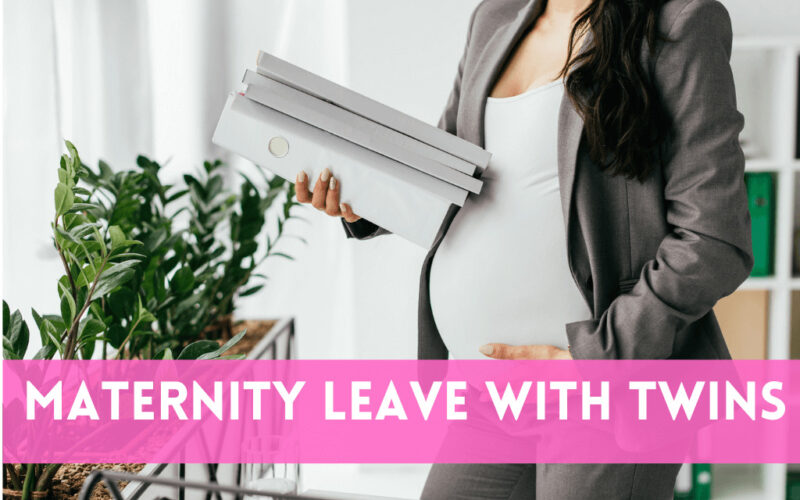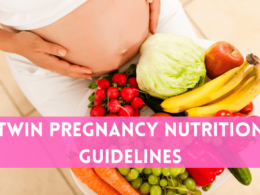In the weeks leading up to and following the birth of a child, a pregnant woman is permitted by law to take time off from her job in the form of maternity leave or parental leave. This type of leave is very important because it enables the mother to rest and recover from the birthing process, nurse her child, form a bond with her newborn child, and adjust to the new dynamics of the family.
Maternity leave is especially important to moms of twins as they have to take care of two babies at the same time. In the USA parents get 12 weeks of unpaid parental leave annually on average even though the amount varies at the state level. However, if you are wondering if the length of your leave will change when you are on maternity leave with twins, there is little to no extra leave for an additional baby.

Maternity Leave with Twins- USA
Maternity leave in the US is regulated under the US Labor Law. According to The Family and Medical Leave Act of 1993 (FMLA), working mothers of newborns or children who have recently been adopted are entitled to 12 weeks of unpaid leave per year from their employers if the employer has 50 or more workers.
This leave is unpaid, job-protected, and can be taken only once a year if the mother is eligible. You will not be eligible for 12 more weeks of maternity leave if you are having twins or multiple babies.

According to a report that UNICEF published, the United States is the only country out of 41 high-income and middle-income countries that do not have a national paid leave policy for either mothers or fathers. That falls short of the minimum requirement set by the World Health Organization, which is 16 weeks.
Maternity Leave for Twins- State Legislation
Currently, the FMLA protects the jobs of employees who are also parents, but it does not cover employees who take paid leave from their employers. Only the company and the worker are responsible for ensuring that the worker is paid appropriately while they are on leave.
This is why federal regulations on maternity leave have been supplemented by many states, which have provided their residents with more extensive maternity leave benefits.These benefits include expanding paid or flexible sick time, expanding access for workers in smaller companies or with less time on the job, right-to-pump provisions that expand on federal law, and pregnancy accommodations.

When it comes to maternity leave for twins, California has implemented one of the best laws among all the states in the USA. In California, people who need to take time off work to bond with a new child are eligible to receive benefit payments through a program known as Paid Family Leave, or PFL.You may be eligible to receive benefit payments for a maximum of eight weeks, depending on the program. Payments are equal to approximately 60 to 70 percent of your weekly wages earned between 5 and 18 months prior to the date on which your claim began. You will have the option of receiving payments either through a debit card or a check.

Paid family leave is an expansion of California’s State Disability Insurance (SDI) program, which provides partial wage replacement for new parents and workers caring for a seriously ill family member, including a pregnant spouse or domestic partner. The program on paid family leave only provides wage replacement; it does not protect workers’ jobs while they are on leave to care for their families.
Other than California, New Jersey and Rhode Island have enacted paid family leave in their states. According to Expecting Better, in 2008, New Jersey passed legislation to create a paid family leave insurance program, and the state began paying benefits the following year. According to the terms of the program, new parents have the potential to qualify for financial assistance equal to up to two-thirds of their wages, up to a maximum amount, for a period of up to six weeks of family leave.

In 2013, Rhode Island passed a law that established paid family leave, also known as “temporary caregiver insurance,” which went into effect the following year, in January 2014. The law in Rhode Island provides for the replacement of up to approximately 60 percent of an employee’s regular wages for up to four weeks of lost wages.
However, as of the year 2016, 12 states still have not enacted any new laws or programs to support family leave either before or after the birth of a child. The United States is still trailing behind when it comes to giving its people much-needed paid maternity leave and post-delivery benefits.
Do You Get a Longer Maternity Leave With Twins?
Even though the struggle is at least two times harder with twins than with singleton babies, the majority of maternity and paternity policies do not extend or even double maternity leave in the event of twin births.
In point of fact, the FMLA does not get doubled in the United States.If your pregnancy was particularly challenging and your doctor believes that you require additional time for recovery, you may be eligible for a longer period of disability leave if you are expecting twins. The duration and payment of this type of extended disability leave depend on the state policies, such as the State Disability Insurance (SDI) in the State of California.
Conclusion
It is exceptionally difficult to take care of two babies at the same time as a working mother. Even though paid maternity leave is a necessity at this point, the laws on maternity leave programs in the United States are not satisfactory, let alone maternity leave with twins.
The FMLA law though provides 12 weeks of leave with job safety, it does not take into account the need for payment during this time. California along with some other states has made some progress in securing payment for the employees. However, the United States still has a long way to go to ensure planned and paid maternity leave for pregnancies with single, twin, and multiple babies.







